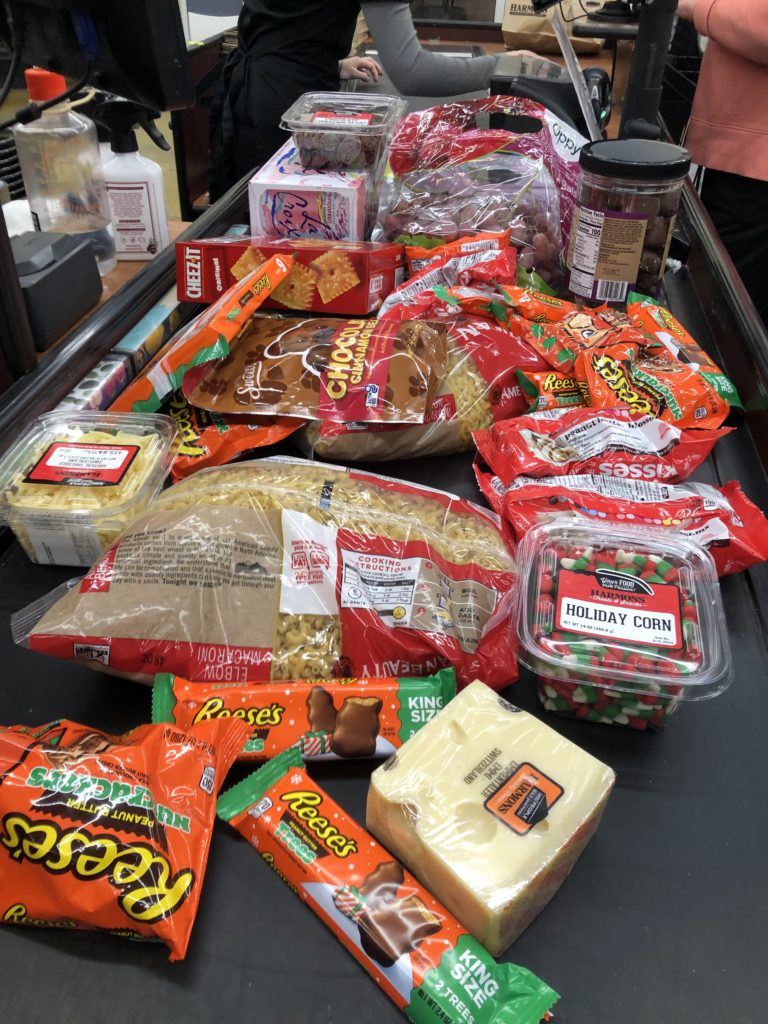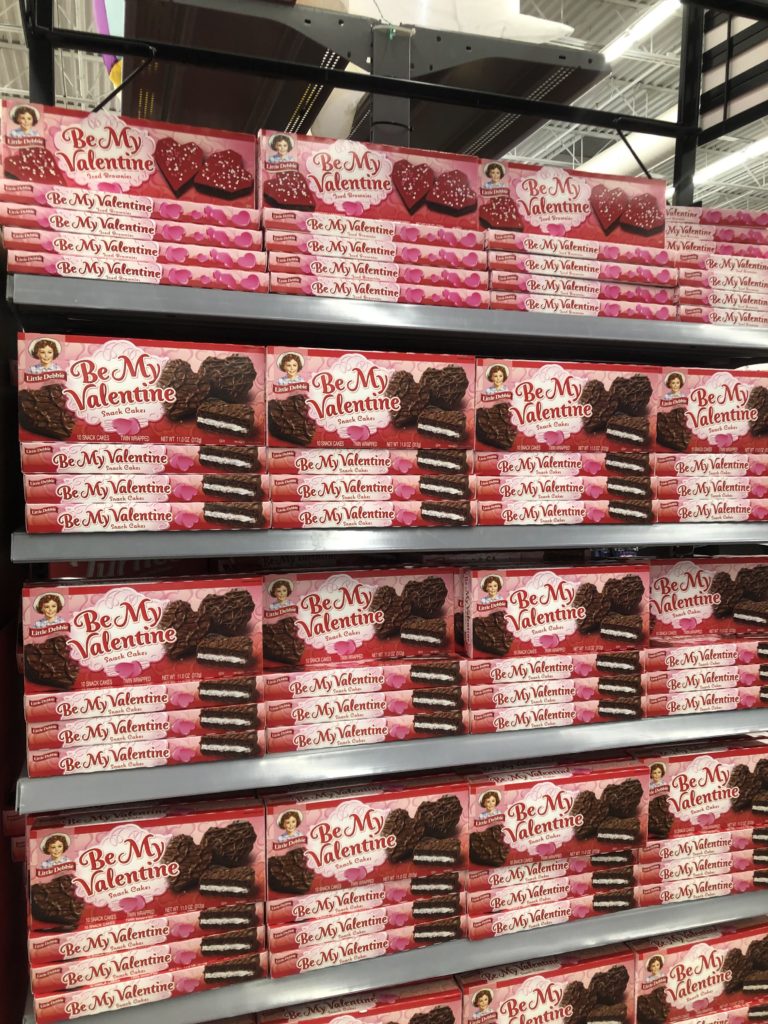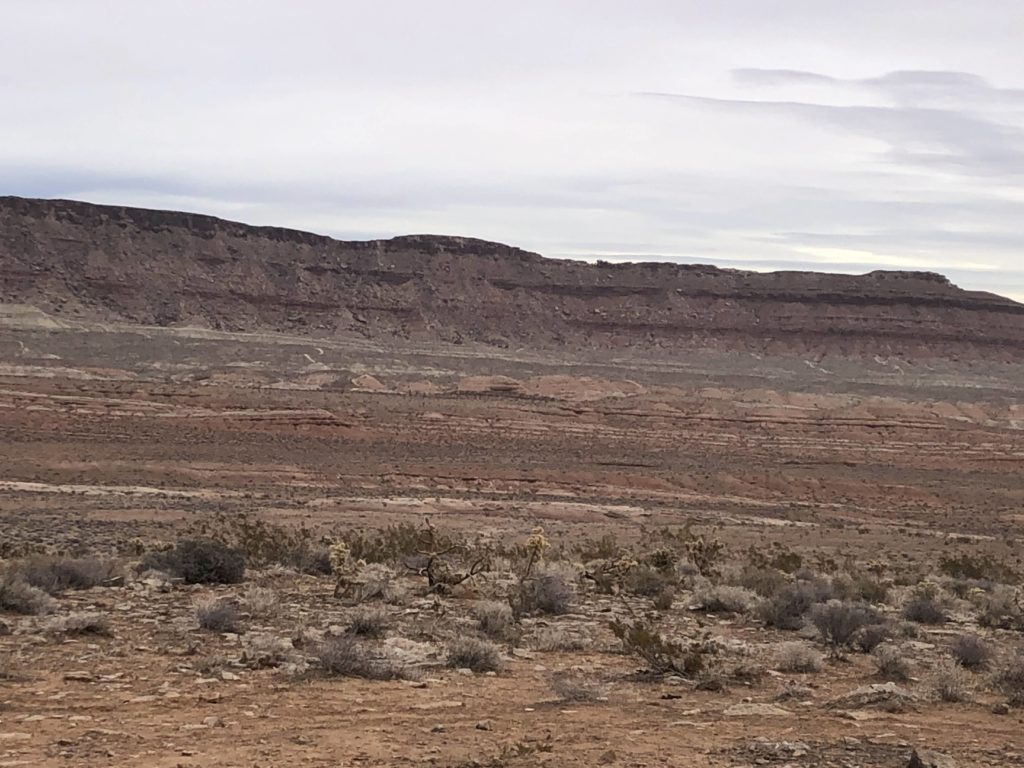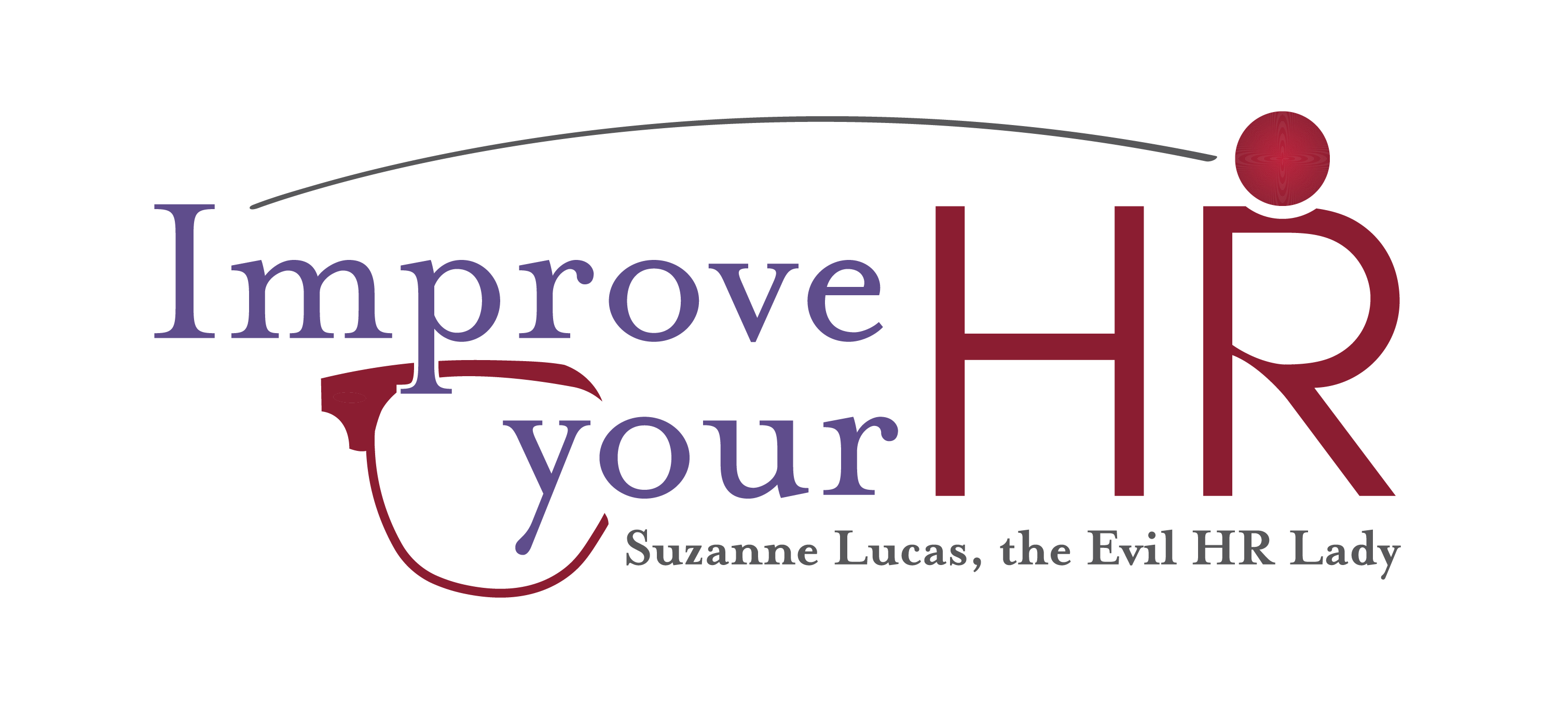 Do those of you who live in the United States have any idea how deprived of Oreo variations the rest of the world is? No, you probably don’t, because you simply go to Walmart and pick up whatever Oreos you want at any time you want. What a country!
Do those of you who live in the United States have any idea how deprived of Oreo variations the rest of the world is? No, you probably don’t, because you simply go to Walmart and pick up whatever Oreos you want at any time you want. What a country!
These were some of the thoughts Offspring #2 and I had when we made our way to Walmart at 6:00 am on December 26. We flew from Switzerland on December 24 (big shout out to American Airlines and British Air for rerouting us so that nasty storms didn’t ruin our holiday trip). Sure, celebrating Christmas with the family is fun, but going shopping? That’s the real fun of a trip to America.
LIsten, dear readers, Walmart–and really all the massive stores in this country–are crazy. The variety of things you can buy are completely overwhelming. Cream cheese chips for cookies? Check. Mass quantities of chocolate covered salted caramels? Check. Cheetos and Takis in all their varieties? Check. Cereal with marshmallows in it? Yum. Diet soda in all sorts of flavors? Amazing.


However, that does not mean that America is perfect. You all suffer from a severe lack of bubble water. I pay approximate $0.30 for 1.5 liters of sparkling water in Switzerland. I paid $1.10 for .5 liters at Walmart. But flavored bubble water was everywhere. Flavored is fine, but plain bubble water is where it is.
And shall we talk about Costco? First of all, they had winter coats for $29.99! I almost bought coats we didn’t need just because they were so cheap. But then I remembered, I’m poor and that would be a waste of money.
The customer service here is so weird, coming from Switzerland where shops and restaurant employees act like you should be grateful they decided to let you in. And, it’s so weird here, that I can find a restaurant open at 3:00 in the afternoon. Fast food is open at that time in Switzerland, but nothing else. No, we eat on schedules in Switzerland, and lunch is finished by 2:00.
But honestly, there are some things that drive me absolutely bonkers here. First is sales tax. Yes, Switzerland has sales tax. Lots of it. (Referred to as VAT–or value added tax.) But it’s included in the price on the shelf. If it says 2,00 on the shelf, by golly you pay 2.00. I hate, hate, hate that they add tax on at the end here. How dare they make me do math in my head.
See also, tipping. Sure, in Switzerland you tip at a restaurant but a franc or two or maybe five francs for a 100 franc meal. (The franc and the dollar are roughly equal.) But certainly not 20 percent that is expected here. I’ve defended the tipping practice before because servers tend to make more money that way, but boy is that annoying.
Driving everywhere is also weird. I don’t own a car as it’s not necessary where we live. We use public transportation or we walk just about everywhere in Switzerland. If we need a car I can rent one through care sharing by the hour. So driving everywhere is absolutely different. My dad lent us his 1996 Toytoa pickup truck though, and it is awesome.
And speaking of differences, what is up with all the people flying in pajama pants? I mean, I’m not opposed, but the Phoenix airport was full of people in pajama pants. I presume this was because it was Christmas morning when we flew out of Phoenix and they had gotten Christmas jammies and now were wearing them to grandma’s house? I don’t know. I’ll see when we fly back to Switzeland on Wednesday. Although, honestly, now I’m thinking about flying in my pajama pants.
Houses are weird here too. We’re in my home town of St. George, Utah, where the population is exploding. New construction everywhere but all with these McMansions. My original plan was to return to St. George when I leave Switzerland, but honestly, I don’t think I can afford to come back here unless you people start sending me money. After 14 years of apartment living houses here seem so big. I’ve adapted to smaller accommodations and have no desire to return to the McMansions of my younger years.
We did even have a positive interaction with the healthcare system here. Offspring 2 had been through two rounds of antibiotics for strep throat before we left Switzerland. He took his last pill on Christmas day and by Thursday it had flared up again. So, off we went to the Corner Clinic, where they take cash and Medicare, which suited us just fine as we don’t have US based insurance. $130 later we left with a prescription for yet a different antibiotic, walked next door to the pharmacy and for $19.99 more got it filled. (We will submit to our Swiss health insurance and the will cover it as we have global coverage, something that is awesome.)
Which brings us to another weird thing about America: Pharmacists have to count pills. In Europe pills come pre-packaged and so you go in, hand you prescription over and the pharmacists plucks it off the shelf and you go on our merry way. Here the pharmacist has a big bottle of pills and she has to count them. We asked the cheerful and customer-service-oriented pharmacist why and she said that she can order them in prepackaged amounts but the cost more and the reimbursement she gets from the insurance companies is so small she can’t afford to order such a thing. (We were in a small, independent pharmacy.) I still think there is some sort of math problem here and you have to pay a fairly high hourly rate for a pharmacist so are you really saving money when ou could process more pills if you bought the pre-packaged stuff? Someone please explain to me.
Despite illness, we were still able to do all sorts of fun things, like going into the desert and shooting targets. I’m a terrible shot, but Offspring #2 is in a shooting club in Switzerland and his uncle taught him how to shoot skeet which he successfully did. Not only did I not shoot anything out of the sky, I felt very happy when I got close enough to a target to rattle it slightly.

Anyway, it’s fun to be with my family, and the offspring had lots of fun with their couins. Offspring #1 is staying for six additional weeks because she does online school and can do it just as easily from here as she can from home. Offspring #2 and I return to Switzerland on Wednesday where we will once again suffer from a severe lack of tacos and high fructose corn syrup. God bless the USA.

Sales tax not on the shelf price is a common complaint, but it’s a practical response to how sales tax works. In any given store, you might have a state tax, a county tax, a city tax, and possibly multiple “special tax districts,” and all but the state tax vary from place to place. In addition, there are probably different tax rates on different kinds of goods. (Food normally isn’t taxed – unless it’s junk food, in which case it is, unless it’s junk food that’s sold in case quantifies, in which case it’s not. At one point, in California, the Board of Equalization publicly stated they couldn’t tell what was taxable and what wasn’t either – but they expected retailers to have gotten it right anyway, once they decided. And it’s probably illegal to collect sales tax on non-taxable items.)
So a company that has multiple locations may well be paying different sales tax rates in every one (and single store retails follow suit because it’s what people expect), and as a rule, especially in states like California where the laws on variances between posted signs and prices charged at the register are so brutal (a difference of $1.00 is a felony, with fines in the tens of thousands of dollars), it’s unmangeable unless you keep prices the same (in the point of sale system) everywhere, and there’s no requirement to show sales tax in the tag. (There’s no prohibition on it either. Technically, the retailer doesn’t have to *collect* sales tax, they only have to *pay* it to the state.)
That excuse doesn’t fly, though. They have to factor that all in at some point regardless of when they choose to do so, so they’re not actually saving any work. And price changes are becoming extremely common, so the idea that it’s too much effort to adjust the prices to account for taxes simply isn’t true. It’s not a huge burden, it’s merely a shift in when the work is being done. I used to do this stuff. All of that was true ten years ago, and has only become more true as time has gone by and these processes are increasingly automated. There is precisely zero justification for not including tax in online retail, such as the Walmart apps–the database is there, it has everything built in, and it’s tracking your position anyway, it would be trivial to show the accurate prices on the items rather than at checkout. The math is already done!!
The real reason why tax isn’t added is much simpler: It entices people to buy more. Same reason why every price has ends in a 9. $1.99 is 1% less than $2, but (and there are plenty of studies that demonstrate this effect) it appears far less. By hiding 10% or more of the total, the stores can entice people to spend more money than they otherwise would, usually far more than 10%.
Gas stations are an interesting case-study here. They show their prices, including tax, and update them extremely frequently. While other retailers sell more stuff, they also generally have more employees, who update the prices regularly anyway. So it IS possible, people do it already. On the flip side, you can’t charge someone a fraction of a cent in the USA, so the price is generally a lie. You may save $0.01 per 10 gallons, but given the price of gas the value is essentially nil. Again, they don’t do it to save you money, they do it to create the perception that you are and thus to entice you to spend your money here and not there.
If this seems cynical, you don’t know enough about how retail works. It is an inherently cynical business. Pretty much everything is geared towards parting you from your money. The tempo of the music is designed to modulate your pace. The fresh flowers at the door of some stores is there to make you think the food is fresh. Same reason they spray the produce–it actually makes it rot faster, but it makes it look more appealing and thus sell faster. The places that give away free samples or free cookies (or fruit in some cases) don’t do so for no reason–it stimulates numerous glands and makes you want more food, and thus makes you buy more. Department stores are no better; there are numerous, and easily-found, studies on how to get people to buy more. End caps, candy at the checkout line, the convoluted layouts, periodic layout changes, the wait times in the lines, even the size of the carts have all been studied in depth and optimized to part you from your cash. Even how stuff is positioned on shelves has been carefully analyzed and optimized. (This is an ongoing process, since people rapidly become aware of and attempt to counteract these systems. It’s an arms race.)
It’s also worth remembering that the USA is the country where the 1/3 lb burger failed because folks thought it was smaller than a quarter pounder. We are not the wisest of all nations. We tend to fall for these tricks relatively easily.
I’m ambivalent about the ethics of this. Sometimes it works out in my favor, and if I don’t want to buy something I’ve got no one but me to blame if it ends up in my cart (well, now that the kids are older anyway). But it’s a simple fact that the answer to “Why does the store do this?” is almost always “Because it makes you buy more stuff”. And blatant, flagrant price manipulation (which is all this is at the end of the day) is the most common and perhaps oldest form of this tactic. If it walks like a duck, quacks like a duck, and swims like a duck, it’s unlikely to be anything other than a duck.
I’ve worked in retail for 40+ years, mostly in management levels and above. I know how retail works.
And I know why shelf prices in the US don’t include sales tax. Mostly, “because that’s how it’s done,” but I also know why it started being done that way.
LOL. Your post brought back SO MANY memories. I was a military wife and lived in Germany for four years in the ’90s (seems like yesterday!). I do remember coming back to the US for visits and then when we moved back here, how WEIRD everything was. Friendly customer service!! Soda refills in restaurants! Restaurants open in the middle of the day!! Grocery stores open ALL THE TIME!!! Good times….
It’s so weird to me that I can go shopping at 10:00 pm here. So weird!
Congratulations on getting to visit home with children!
Thanks! It’s been super fun.
About the pharmacist and counting pills – some of my pills come in pre-packaged containers in the US , but it seems to depend on how many different doses are available and how long the prescription will be taken for. For example, I take a drug that only comes one dosage and it’s a drug that is taken long term so I get it in a prepackaged bottle of 30 pills/30 days. There’s an antibiotic that has specific schedule which comes in a blister package. But most of my prescriptions come in larger bottles and someone has to count the pills. It isn’t aways the pharmacist counting the pills – sometimes it’s a technician but in an independent pharmacy it’s very possibly the pharmacist because just like they can’t afford the pre-packaged pills, they may not be able to afford to hire technicians. They have to pay the pharmacist whether he/she spends their shift counting out the pills or just pulling bottles off the shelf , and while a pharmacist who is just pulling bottles off the shelf can fill more prescriptions in a shift, that doesn’t mean the pharmacy gets enough prescription business for that to matter.
I can perhaps shine a bit of further light on the differences between US and Europe in how we package oral pharmaceuticals. I work for a major Swiss pharmaceutical company (flip a coin and you can guess which one), but I have also worked for two US headquartered Pharma companies, and it is the same for the whole industry. It comes down to bottles vs blisters. It is pretty rare to see pharmacies dispensing drugs in blister packages in the US, though this is the default for Europe and the rest of the world. The driver for this is the very strict US child resistance standards for pharmaceuticals that blisters just don’t meet without extensive modifications. There are many over the counter drugs in blister packs, but have you noticed how HARD they are to open? This is necessary to meet the child resistance standards. If you hand a package to a 3 year old and they can get to the actual tablets or capsules, then it fails the test. By contrast, bottles with child resistant caps are a robust solution to this problem, and pretty much every oral pharmaceutical is launched in bottles in the US. The question of prepackaged vs counted out in the clinic is probably more driven by pharmacy convenience and more significant for generic drugs. I have personally been involved in decisions on how to package new drugs, and I have 100% of the time gone with bottles for the US (usually a 30 day supply per bottle, though sometimes also 90 day option) and blisters for the rest of the world. Interestingly, we prefer 30-day months in the US, but we usually package in blisters in 4-week months, which makes the pill counting a counting of weekly or biweekly blister cards. It would be easier to have it all one way, but US consumers are now pretty comfortable with bottles, and ex-US consumers love their blisters.
THANK YOU!!! That makes a lot of sense.
I’ve been following you and learning from your content since 2012. Had no idea you were from St George! What a small world. My dad raised his “second family” there so I visit often and have three sisters still there. This article made me laugh out loud! Thank you for incredible content for ten years!
I think it’s funny that you bought Swiss cheese in America!
I was about to comment on that. I wonder if the product known as “Swiss Cheese” in America is not actually Swiss. (Similar to how French Fries are not actually a French invention)
Nice to see that you got to enjoy a trip back to the USA even though where you went to visit is part of the more rural areas of the USA. There’s plenty of small towns that will give you that village experience, and be affordable for you too. As far as the housing costs that have become so much higher, we can blame that on what’s called “the elitist rich” who ran out in droves from the urban setting lifestyles to more rural areas and are building all those McMansions and raising property and land costs from affordable to unaffordable. Okay, I in New York, where it is assumed by what questionable average that market value rentals should be $3000-$5000, while most working individuals make less than $60,000/year unless they are in those special tech jobs that average high 6 figure incomes which supposedly 10% of the population here. I can’t explain the high rates logic when it doesn’t help the majority of the population, especially when high taxes don’t effect those who cause these rate increase at all.
I am also surprised that you were gushing about your shopping experiences in a Walmart, (a company that pays its in-store clerks barely enough to survive while its owners are worth millions–a company whose HR tactics you have talked about as negative to employee concerns for various reasons). I guess for that area where you visited there were no supermarkets chains, just big box stores as you mentioned Costco also.
As for the pharmacy experience, I am glad that you were able to get the medication at a privately owned pharmacy after visiting that local Corner clinic, just recheck your billing clams when you get back, because they may have added extra cost on the procedure beyond what you paid upfront, in the followup bill disclosure, so read all the paperwork you received with a fine-tooth comb approach.
As for sales tax, the reason the price on shelves here doesn’t reflect the full cost is caused by how things are taxed as each individual item has a classification for specific kinds of taxation, which determined by federal, state, local and township. For example, here in New York, I pay tax on an item first if it is considered a federal taxable item, then I have to pay NYS tax, plus I pay a county tax and lastly a city tax for any taxable item purchased. Everyone of those departments get paid for the purchase to fund the government spending on each level. What happens in Europe is that those taxes are hidden in the price already. Here you get the transparency of the taxes in the surprise at the checkout counter.
Once again I am glad you had an enjoyable visit to the USA and haven’t forgotten what it means to be part of the USA.
If you are Swiss or live in Switzerland, customs here are weird. If you are Canadian or American or live in Canada or America, Swiss customs are weird. It’s all in the perspective. p.s. no matter how you look at it, there are always 2 guarantees: death and VATS – I mean taxes